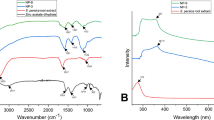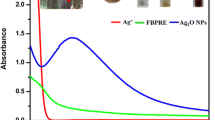Abstract
Natural plant-based materials have several advantages. They are biodegradable, biocompatible, non-toxic, cost-effective, and easily available. It can undergo chemical modification such as capping and stabilizing agent as well. Bio convivial and compatible approaches are made to utilize the renewable source of extract of Cassia fistula as efficient capping and stabilizing agent to prepare zinc oxide nanomaterial. Biogenic way to synthesize the ZnO nanoparticles involves aqueous extract of plant material. The extract along with 20 mL of aqueous solution of zinc acetate (0.2 M) stirred for an hour at pH 12 maintain by addition of NaOH (0.4 M) at room temperature under vigorous stirring for 2 h, which resulted in the formation of a white suspension ZnO nanoparticles. A ZnO nanoparticle prepared by chemical method characterized by XRD, FTIR, FE-SEM and EDAX clearly indicates rod shaped nanoparticles. Whereas, the biosynthesized ZnO nanoparticles using aqeous extract of Cassia fistula flower shows Cluster of rods less than 0.5 µm and ZnO nanoparticles using aqeous extract of Cassia fistula stem shows flat layered pentagonal structure with deposition of particles which was less than1µm with weak physical force.In vitro antibacterial activity of ZnO nanomaterial’s shows maximum zone of inhibition for nanoparticles prepared from stem (CFS-ZnO nanoparticles) against Proteusmirabilis, Staphyllococcusalbus, and Lactobacillus. Antifungal activity of ZnO nanomaterial shows maximum zone of inhibition for nanoparticles prepared from stem (CFS-ZnO nanoparticles). In case of the ZnO nanoparticles prepared by green synthesis shows potency compared to ZnO nanoparticles prepares as it is against S. mutans reported for the first time The ZnO nanoparticles prepared from the green route can be formulated in the form of a mouth wash, or as an intracanal medicament where an antimicrobial agent is required.














Similar content being viewed by others
REFERENCES
J. Santhoshkumar, S. Venkat Kumar, and S. Rajeshkumar, Res. Eff. Technol. 3, 459 (2017). https://doi.org/10.1016/j.reffit.2017.05.001
K. Rahiman, D. Mahendiran, G. Subash, et al., Bionanoscience 7, 530 (2017). https://doi.org/10.1007/s12668-017-0418-y
S. Lakshmi, R. Bai, R. Sharanagouda, and H. U. Nidoni, Green Chem. Tech. Lett. 3, 26 (2017). https://doi.org/10.18510/gctl.2017.321
D. S. Cha and M. S. Chinnan, Crit. Rev. Food Sci. Nutr. 44, 223 (2004). PMID: https://doi.org/10.1080/1040869049046427615462127
K. Sri Sindhura, N. Tollamadugu, K. Prasad, et al., Appl. Nanosci. 4, 819 (2014). https://doi.org/10.1007/s13204-013-0263-4
N. Cioffi, L. Torsi, N. Ditaranto, et al., Chem. Mater. 17, 5255 (2005) https://doi.org/10.1021/cm0505244
L. Huang, D. Li, Y. Lin, et al., J. Inorg. Biochem. 99, 986 (2005). PMID: https://doi.org/10.1016/j.jinorgbio.2004.12.02215833320
T. Jamieson, R. Bakhshi, D. Petrova, et al., Biomaterials 28, 4717 (2007). PMID: https://doi.org/10.1016/j.biomaterials.2007.07.01417686516
K. Y. Kim, Nanomedicine 3, 103 (2007). . PMID: https://doi.org/10.1016/j.nano.2006.12.00217442621
A. Kiruthiga, T. Krishnakumar, and R. Kannan, AIP Conf. Proc. 2142, 150017 (2019). https://doi.org/10.1063/1.5122566
R. Wahab, Y. S. Kim, I. H. Hwang, and H. Shin, Synth. Met. 159, 2443 (2009). https://doi.org/10.1016/j.synthmet.2009.08.006
Y. W. Heo, S. J. Park, K. Ip, et al., Appl. Phys. Lett. 83, 1128 (2003). https://doi.org/10.1063/1.1594835
B. J. Jin, S. H. Bae, S. Y. Leem, and S. Im, Mater. Sci. Eng. B 71, 301 (2000). https://doi.org/10.1016/S0921-5107(99)00395-5
S. Chung, J. Yu, and J. R. Heath, Appl. Phys. Lett. 76, 2068 (2000). https://doi.org/10.1063/1.126257
E. Mohammadi, M. Aliofkhazraei, M. Hasanpoor, and M. Chipara, Crit. Rev. Solid State Mater. Sci. 43, 475 (2018). https://doi.org/10.1080/10408436.2017.1397501
G. Sberveglieri, S. Groppelli, P. Nelli, et al., Sens. Actuators, B 25, 588 (1995). https://doi.org/10.1016/0925-4005(95)85128-3
Zhong Lin Wang, Mater. Today 7, 26 (2004). https://doi.org/10.1016/S1369-7021(04)00286-X
J. A. Rodriguez, T. Jirsak, J. Dvorak, and S. Sambasivan, J. Phys. Chem. B 104, 319 (2000). https://doi.org/10.1021/jp993224g
S. Chandramouleeswaran, S. Mhaske, A. Kathe, et al., Nanotechnology 18, 385702 (2007). https://doi.org/10.1088/0957-4484/18/38/385702
V. K. Shukla, R. P. Singh, and A. C. Pandey, J. Alloys Compd. 507, L13–L16 (2010). https://doi.org/10.1016/j.jallcom.2010.07.156
A. M. J.-B. Kidd, Essentials of Dental Caries: The Disease and its Management, 3rd ed. (Oxford Univ. Press, Oxford, 2005).
S. Thomas, S. Tandon, and S. Nair, J. Ind. Soc. Pedod. Prev. Dent. 18, 115 (2000). PMID: 11324201
T. Nitta, T. Arai, et al., J. Health Sci. 48, 273 (2002). https://doi.org/10.1248/jhs.48.273
W. J. Loesche, Microbiol. Rev. 50, 353 (1986). PMID: 3540569
R. Deshpande, A. Kulkarni, et al., J. Pharm. Res. 4, 3427 (2011).
R. Deshpande, A. Kulkarni, et al., Int. J. Compr. Pharm. 02, 1 (2011). http://journaldatabase.info/journal/issn0976-8157
M. Jadhav, R. Deshpande, et al., Int. J. Biol., Pharm. Allied Sci. 1, 444 (2012).
J. J. Biemer, Ann. Clin. Lab. Sci. 3, 135 (1973). PMID: 4575155
S. Talam, S. Karumuri, and N. Gunnam, Int. Sch. Res. Not., No. 372505, 6 (2012). https://doi.org/10.5402/2012/372505
Z. M. Khoshhesab, M. Sarfaraz, and M. A. Asadabad, Synth. React. Inorg., Met.-Org., Nano-Met. Chem. 41, 814 (2011). https://doi.org/10.1080/15533174.2011.591308
JCPDS, Powder Diffraction File, Alphabetical Index, Inorganic Compounds (Int. Centre Diffraction Data, Newtown Square, PA, 1977). http://worldcat.org/identities/lccn-n78034812.
B. D. Cullity, Elements of X-Ray Diffraction (Addison-Wesley, Reading, MA, 1967). https://www.worldcat.org/title/elements-of-x-ray-diffraction/oclc/256038237.
O. Oprea, E. Andronescu, et al., Digest J. Nanomater. Biostruct. 6, 1393 (2011).
A. Mohan and B. Renjanadevi, Proc. Tech. 24, 761 (2016). https://doi.org/10.1016/j.protcy.2016.05.078
G. Sangeetha, S. Rajeshwari, and V. Rajendran, Mater. Res. Bull. 46, 2560 (2011). https://doi.org/10.1016/j.materresbull.2011.07.046
D. Gnanasangeetha and D. Thambavani, J. Chem., Biol. Phys. Sci. 4, 238 (2013). https://www.jcbsc.org/admin/get_filebio.phpıd=215
L. F. A. Anand Raj and Jayalakshmy E. Ori, J. Chem. 31, 51 (2015). https://doi.org/10.13005/ojc/310105
F. Mirhosseini, M. Amiri, et al., Front. Dent. 16, 105 (2019) https://doi.org/10.18502/fid.v16i2.1361
B. Ramazanzadeh, A. Jahanbin, et al., J. Dent. (Shiraz) 16, 200 (2015).
ACKNOWLEDGMENTS
The authors are thankful to the principal, S.P. College, Pune-411030, India for providing the necessary facility and are grateful to the University Grant Commission for financial support under Minor Research Project scheme (F.47- 1119/14 /General/ 45/ WRO–XII Plan). Dr. Rahul Deshpande’s Oral Health clinic, India for valuable support to carry out this research work.
Author information
Authors and Affiliations
Corresponding author
Rights and permissions
About this article
Cite this article
Gaikwad, S., Torane, R. & Parthibavarman, M. Cassia Fistula–Assisted Green Synthesis, Characterization and Their Antimicrobial Activity of Zinc Oxide ZnO Nanomaterial’s an Intracanal Microbial Agent on Oral Dental Caries. Nanotechnol Russia 15, 760–769 (2020). https://doi.org/10.1134/S199507802006021X
Received:
Revised:
Accepted:
Published:
Issue Date:
DOI: https://doi.org/10.1134/S199507802006021X




